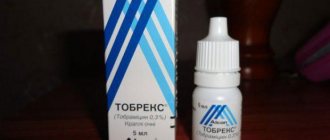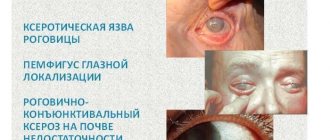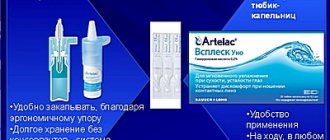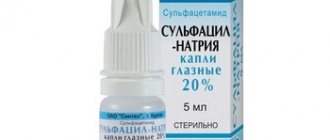132
Author of the article
Tsareva Elena Vladimirovna
Reading time: 11 minutes
A A
The pharmaceutical market today can offer many drugs to treat any disease. Likewise, when treating conjunctivitis, drug manufacturers offer countless eye drops and promise quick recovery. But is this really so and which remedy should I choose? First of all, you need to focus on the doctor’s prescription; only a doctor can determine which remedy can be effective in a particular case. This section will discuss the drug Tsiprolet, which is often prescribed for conjunctivitis, its positive and negative aspects, as well as methods of use.
- Description and composition of the drug
- Medicinal properties and principle of action
- Indications
- Contraindications
- Reaction and side effects
- Preparation
- Features of use in adults
- Use in children
- For different types of illness
- Price and analogues
- Conclusion
Description and composition of the drug
The composition of Tsiprolet is as follows:
- Ciprofloxacin is the active ingredient of the drug. Belongs to the group of first generation fluoroquinolones. Has a detrimental effect on many gram-negative microorganisms. It has a lesser effect on gram-positive bacteria and intracellular parasites.
- Benzalkonium chloride is a preservative that has antifungal, antiseptic and antiprotozoal effects. The substance is included in many eye drops; it is also worth remembering that it destroys the structure of contact lenses.
- Disodium edetate is a preservative; when used for a long time, it can cause allergies and damage the layer of the cornea. For this reason, Tsiprolet is not used longer than the prescribed course.
- Hydrochloric acid – relieves inflammation and disinfects.
- Sodium chloride – has a detoxifying effect, its composition is close to intracellular fluid.
The product is available in the form of drops. The liquid with the drug is colorless or slightly yellowish, poured into bottles.
Description of the drug
The drug Tsiprolet, the indications for which are extensive, is a colorless liquid. The active component of the drug is ciprofloxacin. 1 ml of medication contains 3 mg of active substance. Tsiprolet also contains the following excipients:
- disodium edetate;
- benzoalkonium hydrochloride;
- sodium chloride;
- hydrochloric acid;
- specially prepared water for injection.
The volume of the bottle with Tsiprolet is 5 ml. The drug is used as part of complex therapy for various infectious eye diseases.
Medicinal properties and principle of action
The active substances of the drug are able to penetrate bacterial cells and destroy them from the inside. The microorganism's DNA synthesis is blocked, the genetic material is destroyed and the pathogenic bacteria die.
Tsiprolet has a bactericidal effect on many types of pathogenic microorganisms, both in their dormant state and at the stage of active division. Often this antibacterial agent is used in combination with other antimicrobial therapy , since bacteria are not able to develop resistance to this drug.
Despite this, the chemical composition of the drug is selected in such a way that the drug does not have a toxic effect on the body. And even bacteria are not included in the group of DNA hydrase inhibitors; they do not develop resistance to other antibiotics.
Expert opinion
Ermolaeva Tatyana Borisovna
Ophthalmologist of the highest category, Candidate of Medical Sciences
For these reasons, Tsiprolet is actively used for conjunctivitis. However, these eye drops are ineffective in treating conjunctivitis caused by anaerobic clostridia, cocci and fungi.
Therapeutic effects of eye drops
The antibiotic provokes the death of bacterial cells by suppressing the activity of a special enzyme, DNA gyrase. The drug stops the growth and division of pathogenic microorganisms. The instructions for eye drops included in the package with Tsiprolet indicate that the medicine is active against:
- streptococci;
- staphylococci;
- salmonella;
- Pseudomonas aeruginosa;
- gonococci.
When the medicine is instilled into the conjunctival sac, the medicine is evenly distributed over the surface of the mucous membrane of the eyes.
Indications
The drug in the form of eye drops is prescribed for infectious and inflammatory processes in the eyes and their appendages caused by microbes sensitive to this antibiotic. This category includes the following diseases:
- Subacute or acute phase conjunctivitis.
- Blepharoconjunctivitis, blepharitis.
- Ulcers on the cornea caused by a bacterial infection.
- Keratoconjunctivitis and bacterial keratitis.
- Meibomitis and dacryocystitis in the chronic stage.
- Infection after surgery.
- Attachment of infection after an eye injury or a foreign body entering it, as well as for preventive purposes.
Expert opinion
Ermolaeva Tatyana Borisovna
Ophthalmologist of the highest category, Candidate of Medical Sciences
Tsiprolet can be prescribed as a prophylactic before surgery.
Indications for use
Ciprolet is indicated for the treatment of infectious diseases caused by bacteria sensitive to Ciprofloxacin.
The use of the drug is indicated for:
- conjunctivitis (acute and subacute stages),
- blepharitis, blepharoconjunctivitis,
- corneal ulcers caused by harmful bacteria,
- keratitis and keratoconjunctivitis of a bacterial nature,
- chronic dacryocystitis and meibomitis.
The use of Tsiprolet can be associated not only with the treatment of developed diseases. It is widely used in ophthalmology for preoperative preparation of patients.
It is often used after surgery when a secondary infection occurs. Similar complications can occur after foreign bodies enter the eye. In such cases, treatment with Tsiprolet will also be justified.
Contraindications
Have you used Tsiprolet drops in the treatment of conjunctivitis?
Yes No
The following body conditions are contraindications:
- Pregnancy and lactation period.
- Infancy.
- Viral keratitis.
- Hypersensitivity to the components of Tsiprolet, especially to quinolones.
You should first inform your doctor if a person has the following diseases:
- Atherosclerosis.
- Vascular lesions of the brain.
- Presence of seizures.
- Hematopoietic diseases.
Contraindications of the drug
In addition to the indications, the instructions also list in detail contraindications to the use of the medication. The product should not be used in case of viral infection of the cornea of the eyes or individual sensitivity to its components. The antibiotic is contraindicated for women expecting a child and nursing mothers.
Drops are not prescribed to children under 1 year of age.
If blood supply to the brain deteriorates, the drug is used with caution.
Patients suffering from atherosclerosis of the cerebral arteries should consult a doctor before using drops. The medication is used with caution in the presence of epileptic syndrome, severe kidney and liver diseases, and mental disorders.
Reaction and side effects
Sometimes adverse reactions to Tsiprolet eye drops develop, which manifest themselves as follows:
- Itching and burning appears in the visual organ.
- Pain in the conjunctival area and its redness.
- Photophobia and lacrimation.
- There is a feeling of the presence of a foreign body in the eye.
- Decreased visual acuity.
A person may experience a metallic taste in the mouth immediately after putting drops into the eye. Or there is nausea and allergic reactions.
Expert opinion
Ermolaeva Tatyana Borisovna
Ophthalmologist of the highest category, Candidate of Medical Sciences
If you have any of these side effects, you should stop using the product and seek help from a doctor.
Tsiprolet or Tsipromed: what to choose?
Both medications contain ciprofloxacin, which is a broad-spectrum antibiotic. Both medications belong to the group of florquinolones.
Unlike Tsipromed, Tsiprolet is manufactured both in the form of a solution and in the form of tablets for oral administration.
The drugs differ in the set of auxiliary components included in their composition. Tsiprolet tablets additionally contain the following ingredients:
- corn starch;
- hypromellose;
- titanium dioxide;
- dimethicone;
- polysorbate-80;
- silica.
Tsipromed is recommended for use in cases of eye damage by staphylococci, gonococci, spirochetes, and streptococci. Tsiprolet helps perfectly if the patient has uveitis, keratitis, endophthalmitis, conjunctivitis.
The difference between the medications is that when using Tsipromed, the following side effects more often occur:
- increased secretion of tear fluid;
- increased sensitivity to light;
- swelling in the eyelid area;
- temporary visual impairment;
- feeling of a foreign body in the eye;
- dizziness.
Preparation
Before using Tsiprolet, be sure to read the instructions for the drug and also follow the following recommendations:
- If Tsiprolet is used in conjunction with other eye medications, the interval between them should be at least 5 minutes.
- The drops only need to be instilled; it is forbidden to inject liquid under the conjunctiva and into the front of the eye.
- Before using the drug, you need to remove your contact lenses, and it is best not to wear them at all during the treatment period.
- First, you should thoroughly wash your hands and clear your eyes of purulent discharge.
Additional recommendations
When using the medication, you should follow these recommendations:
- The medicine must not be used for injections under the mucous membrane of the eyes.
- When using the medication together with other agents, the interval between installations should be 10 minutes.
- In the first days of using the product, excessive lacrimation may occur. If such a side effect occurs, treatment should not be stopped.
- When using the medicine, you should refrain from wearing contact lenses. Otherwise, eye irritation may occur.
- Immediately after installing the product, you should refrain from intense physical activity.
- It is necessary to avoid contact of the bottle with drops with a contaminated surface. Otherwise, the risk of additional ophthalmic diseases increases.
- Immediately after using the medicine, you should stop working with complex mechanisms. When using eye drops, a temporary decrease in visual acuity may occur.
Features of use in adults
Drops are applied locally. Instillation is carried out into the conjunctival sac in the sore eye. On average, adults will need to instill 1-2 drops every 4 hours. If the infectious process is acute, it is recommended to instill the medicine 2 drops every hour. After the healing process begins, the dosage and frequency of use are reduced. The duration of treatment is determined by the doctor.
Tsiprolet eye drops: instructions for use, price
226 03/08/2019 4 min.
The human eye is the weakest link in the body. He is often susceptible to various viral and bacterial diseases. Ciprolet eye drops are used to treat inflammatory pathologies and prevent them.
Action of drops
The drug Tsiprolet is an aqueous solution that needs to be instilled into the eyes. In some cases, it is recommended in cases where antibiotics are powerless. Tsiprolet provides protection against bacteria.
Applicable in cases:
- Bacterial conjunctivitis;
- Blepharoconjunctivitis;
- Blepharitis (inflammation of the edges of the eyelids). But this information will help you understand how to treat blepharitis in adults.
- Bacterial keratitis;
- Dacryocystitis;
- Bacterial corneal ulcer. But this article will help you understand what the symptoms may be;
- Treatment of infectious diseases after operations;
- Restoring the eye after injury;
- Bacterial prophylaxis before surgery.
The video shows a description of the drops:
The drug prevents the penetration of new bacteria into the eye shell, disrupts the growth and reproduction of microorganisms and promotes their death.
Instructions for use
If you have symptoms of one of the above diseases - redness of the eye, itching, burning, pus, lacrimation, etc., you should immediately contact an ophthalmologist.
He will make a diagnosis and prescribe medication for you. Do not buy the drug Tsiprolet without doctor's recommendations. Before therapy, you should wash your hands with antibacterial soap.
When instilling, do not allow the nose of the bottle with the medicine to touch the eye membrane.
It only needs to be instilled into the conjunctival sac - the space between the lower eyelid and the membrane of the eye. But how a conjunctival cyst is treated and which means are the most effective is indicated here.
If you have a mild or moderate pathology, you need to instill the medicine 2 drops 6 times a day every 4 hours. As symptoms begin to subside, the dosage and amount of use will need to be reduced. If the pathology has become severe, it is recommended to use drops every hour.
When carrying out the prevention of infections of the eyeball before surgery, take one drop in each eye. After the operation, in order to avoid the ingress of microbes, the drug is used during the first day, 1 drop 3 times a day.
The medicine can be instilled into children over one year of age. The dosage is calculated in the same way as for adults. It cannot be used on newborns.
After instillation therapy, you need to lie down for 10-15 minutes without doing any work; there may be fog before your eyes for some time and visual acuity may decrease.
It will also be helpful to know why ripples may occur.
The uncorked bottle is used within a month. Once the time is up, the medicine loses its expiration date. When closed, the ciprolet is stored for 2 years.
Contraindications
The drug should not be used by pregnant, nursing mothers and children under one year of age. In response to the substances contained in the drops, an allergy may occur. In this case, you need to cancel therapy and buy another medicine. Wearing contact lenses weakens the effect of Ciprolet.
Side effects include redness of the conjunctiva of the eye, swelling, itching, a feeling of sand in the eyes, lacrimation, and decreased visual acuity. When an allergic reaction occurs, nausea may occur, and sometimes an unpleasant taste in the mouth appears. Patients with atherosclerosis and those who suffer from cerebral circulatory disorders should take the medicine with great caution.
Price
The average cost of medicine in Russia is 65 rubles. Price may vary depending on what region you are in.
Analogs
- Garazon . It has an anti-inflammatory effect not only on the eyes, but also on the ears. In addition to bacterial infections, it heals chemical and radiation burns. It is allowed to be used by children over 8 years old, 1 drop 4 times a day. The average cost is 270 rubles. But in what case it is worth using Atropine eye drops, this information will help you understand.
- Tsipromed. It is used in case of infectious inflammation of the eyes. It is not recommended to put drops in the eyes of newborns. The price of the drug is 120 rubles.
- Tobradex. Has a destructive effect on bacteria penetrating through the membrane of the eye. Has a vasodilating effect. Prevents the occurrence of infections. Allowed for children over 12 years old. Average cost - 250 rubles.
- Maxitrol . In addition to protection against bacterial infections, the drug has an anti-allergic effect. Contraindicated for children. The average price for the drug is 350 rubles.
- Dexamethasone. Helps in the prevention of bacterial types of pathologies. Recommended for allergic reactions of the eye. Can be prescribed to children over 12 years old. Average cost - 80 rubles.
Reviews
- Olga, 34 years old: “I woke up this morning and couldn’t open my eyes. They stuck together due to pus. It turned out to be bacterial conjunctivitis. The ophthalmologist prescribed Tsiprolet eye drops. I buried it exactly according to the instructions. After two days, the pain in the eyes went away and less pus appeared. A day later, the unpleasant symptoms completely disappeared.”
- Sergei, 39 years old: “A few days ago I scratched my eye with a branch. The next morning, a red spot appeared on the eye, and it became impossible to look at the light. I went to the hospital, and there I was diagnosed with episcleritis. Tsiprolet drops were prescribed. At first I felt a slight burning sensation from the medicine, but then it went away. After 4 days, the symptoms of the disease began to disappear, and later the pathology completely disappeared. The drops have fulfilled their function.”
- Pavel, 28 years old: “Two months ago one eye became inflamed. It turned out that it was conjunctivitis. The pharmacy recommended Ciprolet. Among the advantages, I note the low price - about 60 rubles. Immediately after the instillation procedure, the eyes began to burn very strongly, and tears began to flow. It was an allergy. I stopped using the drug.”
- Khoroshevsky family: “The child’s eyes are constantly inflamed. They tried many times to treat with different medications, but the disease was in no hurry to go away. The pharmacist recommended Tsiprolet drops. They helped a lot with bacterial conjunctivitis. The pus and itching in the eyes went away after two days. We continued dripping for a couple more days to complete the effect.”
Ciprolet eye drops help in the treatment of eye diseases caused by various bacteria. Before using the medicine, it is best to consult an ophthalmologist, since the drug is not suitable for everyone.
Allergic reactions and side effects are possible, the drug is also not suitable for newborns. The indisputable advantage is the low price of Ciprolet and its effectiveness in the treatment of bacterial inflammation.
Source: https://okulist.online/zabolevaniya/lechenie/medikamenozonoe/kapli/dlya-glaz-ciprolet.html
Use in children
For children, the drug is prescribed after an accurate diagnosis and only by the attending physician. Often, with an infectious lesion of the visual organs, the child’s body temperature rises, he feels general malaise, a headache develops, and pus is released from the eyes.
Tsiprolet is used in this case, 1 drop every 15 minutes for the first 6 hours. If the child is over 7 years old, then you can instill 2 drops. The duration of therapy will be determined by the doctor, on average it is 7-10 days.
Tsiprolet overdose
According to the instructions for use of the medication, there have been no cases of overdose with topical use of the medication. If the product is accidentally ingested, the following complications may occur:
- vomit;
- nausea;
- convulsions;
- headache.
In case of accidental overdose of Tsiprolet, gastric lavage and taking sorbents (activated carbon) are indicated. If necessary, resort to symptomatic therapy. An appropriate antidote for the antibiotic has not been developed.
For different types of illness
Since Tsiprolet is effective against a certain type of bacteria, it is important to first identify the pathogen and then prescribe the remedy. Let's consider the use of Tsiprolet for various types of conjunctivitis:
- Viral. Typically, Tsiprolet is not prescribed for the viral form of the disease. But with a long course of conjunctivitis, lack of personal hygiene rules, or after improper treatment, a bacterial infection may occur. In this case, it would be advisable to prescribe Tsiprolet.
- Bacterial. If there is a bacterial pathogen on the mucous membrane of the eyes, then Tsiprolet, as an antimicrobial drug, will come in handy. A characteristic feature of the presence of a bacterial infection is pus in the area of the optic organ. The most common pathogens are streptococci, staphylococci and pneumococci.
- Allergic. If the doctor considers it necessary to prescribe Tsiprolet for an allergic form of conjunctivitis, then an infection may also be present. In this case, treatment is complex with the mandatory use of antihistamines.
- Purulent. When purulent discharge from the eyes appears, we can talk about a bacterial form of conjunctivitis in an advanced form. Before using Tsiprolet drops, as well as other eye medications, it is necessary to clean the eye area of pus with sterile cotton swabs soaked in boiled water. And only then apply the product.
Price and analogues
Did Tsiprolet drops help you cope with conjunctivitis?
YesNo
Tsiprolet can be replaced with a similar drug with a similar composition. This may include:
- Ciprofloxacin-AKOS.
- Cipropharm.
- Ciprobay.
- Tsipromed.
There are a number of similar antibiotics, but with a different composition; in this case, replacement is made only after consulting a doctor:
- Albucid - the basis of the medicine is sulfacetamide.
- Levomycetin is the active ingredient chloramphenicol.
- Normax contains normofloxacin.
Tsiprolet can also be replaced by other eye drops. Medicines may differ in both their composition and price. One thing they have in common is that they are all antimicrobial agents.
Prices for Tsiprolet may vary depending on the region, but most often the cost does not exceed 70 rubles per bottle.
Analogues of the drug
WE RECOMMEND THE ARTICLE!
Ofloxacin treats diseases of the ENT organs, upper and lower respiratory tract and genitourinary system. Read more >>
Drug analogues are listed in the corresponding table.
| A drug | Active substance | Manufacturer | Price |
| Normax | The Indian-made drug belongs to the fluoroquinolones. The active component of Normax is norfloxacin. The medication also contains auxiliary components:
Normax is used for ophthalmic infections, soft tissue damage, urinary tract pathologies, and otitis media. The drug is contraindicated in case of individual intolerance. Normax is not prescribed to pregnant women, patients under 18 years of age, or nursing mothers. | IPCA LABORATORIES | 130-150 rubles |
| Levomycytin | The main active ingredient of Levomycetin is chloramphenicol. The drops additionally contain boric acid (in low concentrations) and pre-purified water. Levomecitin is contained in a 10 ml dropper bottle | Pharmaceutical company Medoptik | 20-30 rubles |
| Tobrex | The active component of Tobrex is tobramycin. The medication additionally contains:
Tobrex is used in the presence of blepharitis, keratitis, iridocyclitis, blepharoconjunctivitis. The drug is contraindicated in cases of hypersensitivity to its components or a pronounced tendency to an allergic reaction. | Alcon-Couvreur NVSA | 180 rubles |










